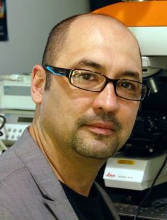Atomically thin sensors made of molybdenum disulfide have been designed which can selectively detect gases and chemicals.
 Alexander Balandin, a professor of electrical and computer engineering.
Alexander Balandin, a professor of electrical and computer engineering.
The research team was led by Alexander Balandin, UC Presidential Chair and professor of electrical and computer engineering at the University of California, Riverside.
Graphene is a two-dimensional layered material that has extraordinary thermal, optical and electronic properties. The discovery of graphene has led scientists to explore other atomically thin, teo-dimensional materials, to see if there are others that demonstrate similarly exceptional properties.
Molybdenum disulfide is one of these 2D materials which has shown significant promise - researchers have proposed single- and few-layer molybdenum disulfide devices for energy, optoelectronic and electronic applications. Sensors are another promising application that has been developed.
Proven selectivity
The sensor devices developed by Balandin's team have two-dimensional channels that are ideal for sensor applications, due to their widely tunable electron concentration and high surface-to-volume ratio. The devices, referred to by the UCR team as "molybdenum disulfide thin-film field-effect transistors (TF-FET)", were tested by a collaborating team at the Rensselaer Polytechnic Institute in Troy, N.Y.
Sensors are everywhere now, including in smart phones and other portable electronic devices. The sensors we developed are small, thin, highly sensitive and selective, making them potentially ideal for many applications.
Prof. Alexander Balandin
The researchers were able to demonstrate the sensors' ability to selectively detect methanol, chloroform, acetonitrile, ethanol and toluene vapors.
The findings have been published in the Applied Physics Letters journal, in a paper titled “Selective chemical vapor sensing with few-layer MoS2 thin-film transistors: Comparison with graphene devices”.
Rameez Samnakay and Chenglong Jiang who were Ph.D. students in Balandin’s lab, and Sergey Rumyantsev and Michael Shur from the Rensselaer Polytechnic Institute, were the co-authors of this study.
Prior functionalization of the sensor’s surface to particular vapors was not required to enable selective detection. The researchers performed the tests with intentionally aged devices, as well as freshly fabricated ones. The aging was done for two months, to prove that the sensors would remain operational when under use for a reasonable period of time.

Schematic of the Molybdenum disulfide (MoS2) thin-film sensor with the deposited molecules that create additional charge. Image credit: Alexander Balandin
Complementary to graphene
Molybdenum disulfide has an advantage over graphene for applications like this - it has a bandgap. This is the feature of the electronic structure of a material which, for example, allows semiconductors to be used to make transistors which can be switched on and off.
When exposed to the test gases, MoS2 exhibited a distinct supression in the electrical current that could be passed through it, much like a transistor in its "off" state. Graphene, on the other hand, merely displays weaker fluctuations in the current under the same conditions, due to its lack of a bandgap.
“Sensors implemented with atomically thin MoS2 layers are complementary to graphene devices, which is good news. Graphene has very high electron mobility while MoS2 has the energy band gap.”
Prof. Alexander Balandin
These low-frequency current fluctuations were used as an extra sensing signal
is the uniqueness found in atomically thin graphene and molybdenum disulfide gas sensors. Traditionally, the variation in the resistance of the active channel of the device or the variation in the electrical current through the device is used by chemical sensors.
Promising applications in high-temperature electronics
In a paper titled High-temperature performance of MoS2 thin-film transistors: Direct current and pulse current-voltage characteristics, Balandin's team have previously confirmed the operation of molybdenum disulfide atomically thin film transistors at high temperature.
High temperature applications such as energy generation, oil field instruments and turbine engine control in aerospace, require electronic components for sensors and control systems which can function at temperatures exceeding 200°C.
However, circuits and transistors that can operate at temperatures exceeding 200°C are not common. Conventional semiconductors that are made from gallium nitride and silicon carbide can be potentially used for operations at high temperature. However, they are not yet cost-effective for applications in very large volumes. New material systems for producing field-effect transistors sensors that function at high temperatures are required for many applications. This makes electronics based on MoS2 seem worthy of further development.
References and further reading